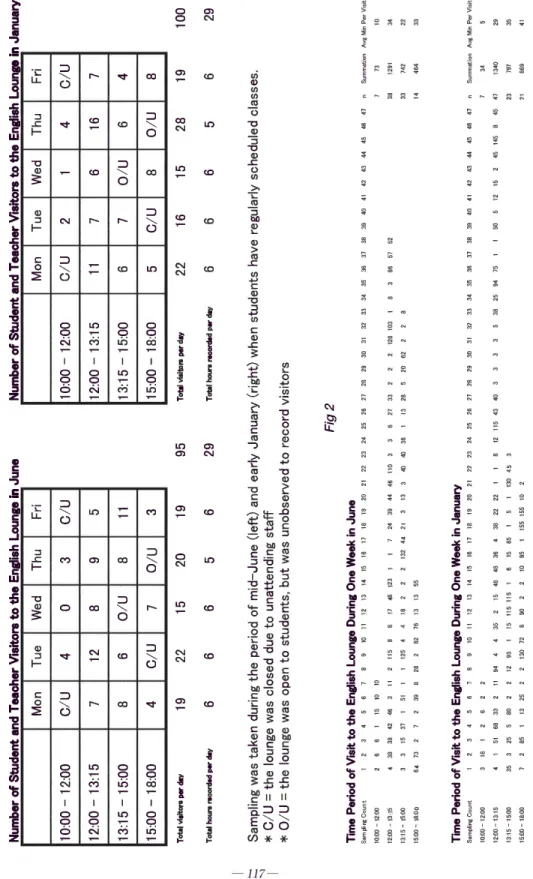The Effectiveness of an English Lounge and Second Language Acquisition
著者別名 Steve KAWAMURA
journal or
publication title
Otemae Journal
volume 9
page range 113‑123
year 2009‑03‑31
URL http://id.nii.ac.jp/1160/00000100/
Creative Commons : 表示 ‑ 非営利 ‑ 改変禁止
http://creativecommons.org/licenses/by‑nc‑nd/3.0/deed.ja
TheEffectivenessofanEnglishLoungeand SecondLanguageAcquisition
SteveKawamura
Summary
AprojecttostudytheeffectivenessofanEnglishloungewasimplementedatOtemae University,Japan.TheconceptformakingtheEnglishloungewasforstudentstohavean informalnaturalisticenvironmenttofeelatease,socialize,andtocommunicateinEnglish.
Studentsweresampledoveraspanoftwofive‑dayobservationstoevaluateitseffective‑
nessinsecondlanguageacquisition.
Keywords:language,acquisition,English,lounge,naturalistic
Introduction
Searchforaneffectivelanguagepedagogyhasbeenstudiedforstudentstoachievesec‑
andlanguageacquisition(SLA).Differenttheoriesandmethodologieshavebeenstudied withoutaprovensuccessasBell(2003),Brown(2001),Kumaravadivelu(2001)and
othershavetriedtoformulateinstructedSLA.(Brown,2007,p.18)Despitetheeffortand headwaythathasbeenmadetoimprovetheclassroomteachingmethods,manyEnglish asaforeignlanguage(EFL)learnersarenotproficientEnglishcommunicators.
Learnersstillhavetroublewithpronunciation,lackoffluency,andtheinabilitytoexpress theiropinionintheirsecondlanguage(L2).Reasonsforthismaybenumerousandmay notbeduetoexclusivelyusingL2,butthemostlikelyandrecurringreasonforthelackof fluencyisduetoinsufficientL2exposuretopossesscognitiveacademiclanguageprofi‑
ciencyskills(CALPS)(Collier,1987,H‑esmer,1994,Cummins,1981).Inadditiontofor‑
一 ヱ13一
malinstruction,aqualitativestudywasdonetoobservetheeffectanaturalisticapproach wouldhaveonSLAinaschoolcommunicationlounge.
Background
Theuniversity'sEFLprogramwasfirstimplementedasapreparationforstudentsto enrollinacademicinstitutionsabroad.Itquicklyexpandedtoincludelearnerswhowere notplanningtostudy‑abroadbuttosimplyfurthertheirEnglishskills.Forovertenyears, theschool'sEFLprogramconsistedofthreeandlatertofourlevelstaughtfivedaysa week.SeveralstudentstookEnglishfourorfivetimesaweekandshowedmarked increaseinL2fluency.ThoughtheprogramencouragedlearnerstouseonlyL2during
the90minuteclasses,therewaslittleopportunityforstudentstopracticeinanaturalset‑
tingduetolimitednative‑speaking(NS)Englishinstructors.Later,withtheincreasein firstlanguage(Ll)instructorsattheschool,thenextstepincultivatingthestudents' SLAwastomakeEnglishspeakinguseeasilyaccessibletoallstudents.Agreateroppor‑
tunityforL2useinanaturalisticenvironmentwasnecessary.
StatementofPurpose
ApilotprojecttostudytheeffectivenessofanEnglishloungewasimplementedat OtemaeUniversityinItamiCity.Thecommunicationloungewastobeaspaceforstu‑
dentstointeractinEnglishwithteachersandstudents.LightbrownstatedaboutGuiroa's initialfindingthatdecreasedinhibitionwasamajorfactorinimprovedauralskills(Guiora etal.1972).Toobservethisphenomenonthekeytothelounge'ssuccesspendedonan
informalenvironmentsothatextrovertedaswellastheintrovertedstudentsinclasscould alsofeelcomfortableenoughtoenterthelounge.Communicationusingopen‑endedcon‑
versationswasthegoalandconceptfornaturalisticlanguageacquisition(NLA)
(Lightbrown,1999,p.55).Sincethelounge'sinception,twofive‑dayintervalquantitative observationsweretakenoveroneacademicyeartoobserveL2usagefrequencyandverti‑
calvariation.
Method
Attemptingtoattainanaturalisticapproach,creatingacomfortableandinvitingspace wasnecessary.Insteadofgoingthroughformalinstitutionalprotocoltoobtainacommu‑
nicationloungethatcouldhavetakenafullyear,theavailableresourcesandspacewere utilized.Forthelackofadesignatedspace,ateacher'sofficewasusedforthelounge
TheEffectivenessofanEnglishLoungeandSecondLanguageAcquisition
measuringapproximatelysixmeterslongbyfivemeterswide.Moreover,halfofthespace waspartitionedtooccupytwoteachers'workspace.Theotherhalfoftheroomnearestto
theentrywasmadeintoalounge.Despiteitssize,oneofthebestfeatureswasitsconven‑
Tentlocationplacedwherestudentsoftenpassedonthewaytoclass.
Materials
Majorchangeshadtobemadefromthepreviouslyvacatedteacher'soffice.Theover‑
sizedofficefurniturethatmayhavebeenadequateforasingleteacherthatleftthem,were
overlyspace‑consumingandhadtobereplaced.Withtheabsenceofabudgetwhatsoever toopenthelounge,existingofficefurniturewascollectedfromtheschool'sstorage:three
swivelo伍cechairs,onesleeko伍ce‑stylecouch,acoffeetableandsidetable,teacher's desks,filecabinets,chairs,andtwopartitions.Eventhoughthefurniturecollectedwas
adequate,itwasamodest‑lookingoffice.Althoughmoreextravagantrenovationideas
weredesired,someofthelessexpensiveoptionswereimplemented;forexample,the
plainwhitewoodenofficedoorwasfittedwithathinverticalwindowsothatstudentscould seeinside.Inaddition,thewallswerepaintedaswellassupplyingacollectionofEFL
booksandmagazines.Forcomfort,manyoftheitemsweredonatedbyteacherssuchas
anelectrichotpotformakingteaandcoffee,severalplants,arefrigerator,amicrowave,
andseveralimportedgames.
Despitelackinginanyinteriordesigncoordination,theroomlookedsimpleyetcomfort‑
able.Uponcommencement,thereweren'tanysignsoradvertisementsofanysort.The loungewasknownamongstthestudentsmorebywordofmouth.
Procedure
Thecommunicationloungedidnothavestaffdedicatedtolookafterthelounge.
Instead,itwasonlyopenwhentherewasateacheravailable.Inspiteofthetimeirregular‑
ity,itwasgenerallyopenbetween10:00to18:00.Theattendingpersonnelwerefull‑time teachersorpart‑timeteachers.Actualnumbersweresampledinaspanoftwoseparate five‑dayintervalsineachofthesemestersduringtherecordabletimes.
Inadditiontoobservations,aquestionnairewasconductedtoshedgreaterinsighttothe loungevisitsfromthestudents'perspective.Thefeedbackwasanunsolicitedquestion‑
naireputintotheloungeforstudentswhovisitedoveraconsecutivefive‑dayperiodin
一 ヱ15一
January.Itwasabrieffive‑questionsurveyformthatwassubmittedinasealedreturnbox.
Thequestionswereonlywritteninthestudents'L21anguage,English;therefore,they werekeptbriefandsimpleforlowerlevelstudentstoaccuratelyansweraswell.Although thefirstfourquestionsweremultiple‑choice,thelastsurveyquestion,studentswerefree towritedowntheirreasonforvisitingthelounge.Thispossiblymayhaveinhibitedlower L2studentstowriteananswer,itwasdesignedsothatstudentscouldbefreetowritetheir ownresponseswithoutpredeterminedchoices.Interpretationsfromgeneralobservations weredrawntolatercorrelatewithstudentquestionnaireresults.
Results
Thedataseenonfigurelwasdividedintotimeperiodstoreflectthelowandhighfre‑
quencyvisitsoftheday.Generally,itwasquietbeforenoonandmoderateinthelateafter‑
noon.Asseenonthechart,thebusiesttimeswereduringlunchandearlyafternoon.
Thefive‑dayobservationsshowamodestincreaseinthenumberofvisitorsfromJuneto Januaryofthefollowingyear(N=95toN=100),butthesamplingswereerratictocon‑
dudethatthenumberofvisitorswereduetoanincreaseinusageofthelounge.
Furthermore,theydonotindicatehowmanystudentsvisitedtheloungeduringthe unmonitoredopenhours,recordedonthechartasO/U.Inadditiontotheapproximately 100studentswhovisitedtheloungeduringthefive‑dayperiod,thenextobservation revealsthetimedurationofeachvisit.
Duringthesamesurveillanceasdocumentedabove,theamountoftimeroundedupto thenearestminutewasrecordedexcludingsimpleinquiriesbystudentswhowerelooking forsomeone.
Figure2aboverevealsquantitativelythetimeeachvisitorspentduringthedifferent intervalperiodsthroughouttheday.Themonitoreddatademonstratesthatvisitorswho cameinthemorningdidnotstaylong;theyoftencametoaskspecificquestionsbefore noon.Duringthe12:00to13:15period,studentsandteacherswereonlunchbreakand cametotheloungetosocializeoreat.Thevisitorssubsequenttolunchperiodweremain‑
lystudentswhohadfreetimebetweenclasses.
Fromthesurveyedsampleinterval,anaverage19visitorscametotheloungeinone
自 M NumberofStudentandTeacherVisitorstotheEnglishLoungein MonTueWedThuFri 10:00‑12:00C/U403C/U 12:00‑13:15712895 13:15‑15:0086O/U811 15:00‑18:004C/U70/U3 Totalvieitoraparday Tαヒ●lho膝r8「●00圓鮒P●「幽day
19 6
22 6
15 6
20 5
19 6
inJune 95 29
Fig1 Numb●rof翫ud耐a締dT●80h●rVisitorstotheE耐8トしOU㎎●i纐 MonTueWedThuFri 10:00‑12:00C/U214C/U 12:00‑13:151176167 13:15‑15:00670/U64 15:00‑18:005C/U80/U8 Totalvisitorspsrday TotalOm●dP●rdoy
22 6
16 6
15 6
28 5
19 6 Samplingwastakenduringtheperiodofmid‑June(left)andearlyJanuary(right)whenstudentshaveregularlyscheduledclasses. *C/U=theloungewasclosedduetounattendingstafF *O/U=theloungewasopentostudents,butwasunobservedtorecordvisitors TimePeriodofVisittotheEnglishLoungeDuringOneWeekinJune SamplingCount123456 10:00‑12:0026611510 12:00‑13:754383842463 13:15‑15:00331537151 15:00‑18:00647327239
78 io 112 11 828
91011121314151617181920 115881748123117243944 12544182221324421313 26276131355
Fig2 212223242526272829303132333435363738394041424344454647 461103362733222128103183865752 34040361732852062228 TimePeriodofVisittotheEnglishLoungeDuringOneWeekinJanuary SamplingCount123456 io:oo‑iz:ooaisizsz 12:00‑13:75415768332 13:15‑15:00353255802 15:00‑18:00728511325
7 2 11 2 2
89101112131415161718192021 94443521548483643822221 1295115115115161585151130 2130728902210951155155102
einJanuary 100 29 nSummationAvgMinPerVisitor 77370 38129134 3374222 1446433 22232425262フ2829303132333435363738394041424344454647n 18121154340 453 7 333353825947511505121524514584547 23 zi SummationAvgMinPerVisitor 345 134029 ア9735 assai
望 ①国時 ︒牙 窪 ①ωω︒h磐 国轟 一房ゴ 8 巨 αq窪 巳 ω①8 巳 雷 轟 仁茜 ①>B 三 の三 8
day.Somestayedforafewhourswhereasmanysimplycametogreet.Outofthe19visi‑
tors,thetimeintervalvariedtremendouslyfromlminuteto155minutes,or26minuteson average.Theobserveddatadoesnotmakeanydistinctionsthefrequencyofvisitsofany onestudent.Thechartsaretwoseparatefive‑daywindowsofmonitoreddatainthespring andfallsemesters.Anotherfactorthatmustbeweighedisthatnotallofthepossiblestu‑
dentswouldhavevisitedtheloungeduringthoseparticulardayssurveyed.Still,theuni‑
versifyhasapproximately200studentstakingEFLclasses,butitcannotbeconcluded exactlywhatpercentageofstudentsusedtheloungeunlessthedatawascollected throughoutthesemester.
Giventheselimitations,thesampledatacanstillbeareflectionofthenumberofvisitors inanygivendayduringtheacademicyear.
Qualitativeobservationsrevealedthatstudentloungevisitorscouldbeseparatedinto twogroups,thelow‑frequencyandhigh‑frequencyvisitors.Theformergroupoftenhada specificpurposesuchasqueriesabouthomework,classes,ormessages.Thosestudents oftentalkeddirectlywithteachers.Theywereirregularvisitors,sotheirvisitswereoften notprolonged;theyweregenerallyonetotenminutedurations.Incontrast,thehigh‑fre‑
quencyvisitorsweremostlytheL21earnerswithawillingnesstocommunicate(WTC).
TherewasnoobservedcorrelationbetweenthestudentswhovisitedandtheirL2skill level.
Eachofthetimeperiodsasshowninfigurelhaditsowndynamicvariationofstudents, purpose,skilllevel,andL2usage.
Duringlunchtime,thetrafficofstudentswasgreatest.Itbecamearegularoccurrence forthreetosevenstudentstohavelunchwithavailableteachers.Theybecameaccus‑
touredtoservingthemselvestohotcoffeeortea,ortoheattheirlunchwiththemailable microwaveoven.Additionalstudentscametoaskquestionsortotalkwithfriends.Inthe presenceofNSteachers,thistimeperiodwasthebestopportunityforEnglishcommuni‑
cation.MultipleNSinteractionwasspokeninnaturalspeedandspeech.Atfirst,students mentionedthattheycouldnotunderstandwhatwasbeingsaidwhenlisteningamongtwo NSconversations,butlaterthatsameyear,severalstudentscommentedthattheyhad becomeaccustomedtohearingNSconversationsandcouldcomprehendconversations.It wasarareopportunityforanyoneormorestudentstonotonlylisten,butalsotopartici一
TheEffectivenessofanEnglishLoungeandSecondLanguageAcquisition
pateinaconversationwithmultipleLlEnglishspeakers.Inmostcases,studentswere accustomedtospeakingone‑on‑onewithateacherintheclassiftheywerefortunate;how‑
ever,tohavehadinteractionwithmorethanoneNSteachersimultaneouslywasaunique andopportunesituationforSLA.
Afterthelivelylunchperiod,manyofthevisitorshadclassestoattend,orstudentswent homeresultinginfewernumbers.Nevertheless,therewerethosewhoremainedafter lunchmixedwithnewvisitors.Duringtheearlyafternoon,thestudentsweremainly thosewithgapsintheirclassscheduleorfreetimebeforegoingtotheirpart‑timejobs.
Towardsmid‑afternoon,itwasacombinationofthosewhocamebeforeoraftertheirclass, andthosethathadafreeclassperiodpriortheirnextclass;similarly,StudentAssistants
(SA)cametodopart‑timework.AlthoughtheywerenotpaidtomakeEnglishconversa‑
tionwithstudentsorteachers,thelanguageusedduringworkwasEnglish.Itcreateda goodEnglishspeakingsetting,forexample,whenteachersinteractedabouteventsor workassignmentswithanSA,visitorswereautomaticallydrawnintotheconversationdue
tothecloseconfinesoftheofficeandlounge.
Duringthespringsemesterobservation,studentswereinterestedinplayingsomeofthe wordgamesmailablesuchasBoggleTM,ApplestoApplesJuniorTM,orgeneralgamessuch
asJengaTMandQuartoT"̀.Attimes,shystudentsdidn'thavemuchtosaywhiletheywere inthelounge.Thegamesweregoodicebreakerssincetheyprovidedanoutletforthem toparticipatewithoutfeelingobligedtocontinuallyspeak.Duringthegame,theyhadan opportunitytosayafewwords,orsuddenlytalkedalotoutofexcitement.
Astheafternoonprogressed,therewerecertainregularstudentsthatcamebeforeclass, intermediateandupper‑intermediateEFLsinceclassesstartedlateintheday,16:30and l8:10respectively.Thecontrastingdynamicsintheloungetransformedagain.Thesestu‑
dentsweregenerallyintheirthirdorfourthyearofuniversityandhadbuiltclosefriend‑
shipsamongsttheEFLstudents.Nonetheless,regardlessofwhichEFLclasstheytook,if thelearnersstayedlongenoughinthelounge,theybecamefamiliarwithteachersand otherstudentsofvaryingL2skilllevels.Asobservedinfigure2,thestudentstendedto staylongerpervisit.ItwasaregularoccurrenceforafewstudentswithahighWTCto spendmostoftheirtimeintheloungeeventhoughtheyhadtwoclassperiods(3hours) openpriortotheirnextclass.Manyofthosewithclassschedulesasmentionedwere
一 ヱ19一
observed,butfeweverstayedthatlong,andifso,theydidsosporadically.Inaddition, instructorswerenotalwaysavailabletointeractintheloungeatthistime,sostudents weresometimeslefttoconversewitheachother.Theabsenceofteachersintheconver‑
sationresultedinstudentsconversinginLlratherthanL2,anobservedresultthattwo studentswhospeakthesameLllanguagewouldusetheirnativetongueratherthanboth usingL2.
Besidestheobservationstakenovertwofive‑dayintervals,datawascollectedfromastu‑
dentquestionnaireasshownbelow.DuringtheJanuaryfive‑dayinterval,19studentscom‑
pletedthequestionnaireform.Sinceitwasanunsolicitedsurvey,itisuncertaintheexact percentageofparticipatingvisitorswhofilledoutthequestionnaire.Calculatingthe observedmeanofvisitsperweekfromfigure1,approximately20%studentparticipation couldbeextrapolated.
Theresultsofthequestionnairerevealedthatthefrequencyofvisitsperweekvaried fromoncetosevenormoretimesaweek.Thethreestudentswhowereindicatedwiththe resultof̀7'above,notedthattheycameinexcessofseventimesaweekormultipletimes duringtheday.Whenasked,"Howmuchtimedoyouusuallyspendintheloungeeach timeP"thestudents'responsevariedfrom5to60minutes.Thirdly,whenaskedtoindi‑
catehowmuchoftheirvisitwasusedinspeakingL2,theirresponsesweresimilarlytabu‑
latedrangingfrom3minutesto40minutespervisit.
Inadditiontohowmuchtimewasspent,thequestionnaireexploredwhattheydidand thereasonfortheirvisitstothelounge.Themostcommonresponsewaschattingwith theotherremainingthreereasonsstillbeingequallyprevalentwere:tohavelunch,to meetfriends,andtoaskquestions.Inthefinalquestion,studentswerefreetowritedown theirreasonforvisitingthelounge.Theirvariedanswersweregroupedintofourrespons‑
es:itisenjoyable,toaskquestions,totalkinEnglishwithteachers,andlastly,fornorea‑
son.
Oneofthesignificantobservationsthatcouldbeconcludedfromthissurveywasthat studentusedalargepercentageofthetimespeakinginL2.Ifthetotalnumberofminutes usedspeakinginEnglishpervisitwasdividedbythetotalnumberofminutesspentper visitinthelounge,studentsspentapproximately50%oftheirtimeusingL2.With19vol一
一 ヱ20一
国鳴﹂
Fig3 QuestionnairetakenoveraoneweekperiodinFebruary 望 ①国時 ︒牙 窪 ①ωω︒h磐 国轟 一房ゴ 8 巨 αq窪 巳 ω①8 巳 雷 轟 仁茜 ①>B 三 の三 ︒
untaryquestionnaireparticipants,anaverageof14minutespervisitwasspentcommuni‑
GatinginL2.Moreover,ifanaverageofthreevisitsperweek(fig3)waspaidtothe lounge,itcouldbecalculatedthat42minutesonaverageperweekwasusedinL2commu‑
nication.
Discussion
Thequestionnaireaskedstudentstoindicatetheirresultinminuteswhichmayexplain whystudentsdidnotputresultsgreaterthan60minutes.Calculatingoveronehourmay havebeeninhibitingorthefrequencyoflongvisitsofover60minutesmayhavenotbeen frequentenoughtoindicateonthesurvey.Incontrasttothestudentquestionnaire results,figure2revealsobservedtimeperiodsinwhichthirteenvisitsactuallyexceeded 60minutesinJune,andnineteenvisitsinJanuary.
Questionnairesalsohaveinaccuraciessinceeachvisitmayhaveadifferentpurposeand activityonanygivenday.Forvisitorstosurmisetheiryearlyactivityduringtheyearona
"quick"questionnairemayresultinsomediscrepancies .
Conclusion
Theobserveddatacollectedovertwoseparatebutconsecutivefive‑dayintervalsdemon‑
stratedthattheloungewasfrequentedbyapproximately100visitsperintervalandhada significantimpactonL21earners'verticalvariationoverthecourseofoneacademicyear.
ManystudentsspokeL2majorityofthetimeincludingseveralregularstudentsthatspoke L2predominately.Furthermore,amongtheregularvisitors,L2wasspokenmoreexten‑
sively(60‐210minutesperweek).
Althoughthereisinsufficientobservationandtestingtoquantifyvisitor'sverticalvaria‑
tionfromtheseobservedandsurveyedresults,itcanbestatedthateachstudenthadan opportunityforpracticalL2usageutilizinganaturalisticlanguageacquisitionapproach.
Still,othersprogressedtocomprehendingmultipleNSconversationsandwerenotonly abletolisten,butalsocomprehendandinteract.
一 ヱ22一
TheEffectivenessofanEnglishLoungeandSecondLanguageAcquisition
References
Brown,D.(2007).PrinciplesofLanguageLearningandTeaching.WhitePlains:Pearson Education.
Collier,V.P.(1987)Ageandrateofacquisitionofsecondlanguageforacademicpurposes.
TESOLQuarterly,21,617‐641.
Cummins,J.(1981)AgeonarrivalandimmigrantsecondlanguagelearninginCanada.A reassessment.AppliedLinguistics,2,132‐149.
Ellis,Rod.(1997)SecondLanguageAcquisition.Oxford:OxfordUniversityPress.
H‑esmer,H.(1994)AssessmentandteacherperceptionsofESLstudentachievement.English Quarterly,26:3,5‐7.
Lightbrown,P.,&Spada,N.(1999).HowLanguagesareLearned.Oxford:OxfordUniversity Press.
一 ヱ23一

